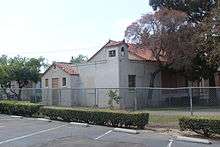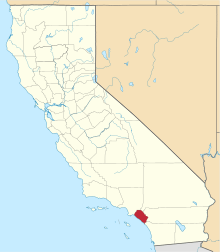Villa Park, California
| Villa Park, California | ||
|---|---|---|
| General law city[1] | ||
| ||
| Motto: The Hidden Jewel of Orange County[1] | ||
 Location within California and Orange County | ||
| Coordinates: 33°48′58″N 117°48′40″W / 33.81611°N 117.81111°WCoordinates: 33°48′58″N 117°48′40″W / 33.81611°N 117.81111°W | ||
| Country |
| |
| State |
| |
| County | Orange | |
| Incorporated | January 11, 1962[2] | |
| Government | ||
| • Type | Council–manager[1] | |
| • Mayor | Diana Fascenelli[3] | |
| Area[4] | ||
| • Total | 2.078 sq mi (5.383 km2) | |
| • Land | 2.078 sq mi (5.383 km2) | |
| • Water | 0 sq mi (0 km2) 0% | |
| Elevation[5] | 341 ft (104 m) | |
| Population (April 1, 2010)[6] | ||
| • Total | 5,812 | |
| • Estimate (2013)[6] | 5,951 | |
| • Density | 2,800/sq mi (1,100/km2) | |
| Time zone | Pacific (UTC-8) | |
| • Summer (DST) | PDT (UTC-7) | |
| ZIP code | 92861 | |
| Area code | 714 | |
| FIPS code | 06-82744 | |
| GNIS feature IDs | 1661640, 2412158 | |
| Website |
villapark | |
Villa Park is a city in Orange County, California, United States. It was incorporated in 1962. As of the 2010 Census, the city had a population of 5,812, the lowest population for a city in Orange County.
The city is largely zoned for single-family residences on lots that average about 20,000 square feet (1,900 m2), or 1/2 acre, in size. Within the city limits there is one small shopping center. City Hall, including a community room, and a branch of the Orange County Public Libraries system is adjacent to the city's only shopping center.
History
After the 1769 expedition of Gaspar de Portolà, a Spanish expedition led by Father Junipero Serra named the area Vallejo de Santa Ana (Valley of Saint Anne). On November 1, 1776, Mission San Juan Capistrano became the areas first permanent European settlement in Alta California, New Spain. In 1810, the Spanish Empire granted 62,500 acres (253 km2) to Jose Antonio Yorba, which he named Rancho Santiago de Santa Ana. Yorba's rancho included the lands where the cities of Olive, Orange, Villa Park, Santa Ana, Tustin, Costa Mesa and Newport Beach stand today.
After the Mexican-American war in 1848, Alta California became part of the United States in 1850 and American settlers arrived in this area.
Villa Park was known as "Mountain View" in the 1860s. The U.S. Post Office refused to allow the local post office to be so named as there was already a post office with that name in Mountain View), so the post office and hence the area came to be called Villa Park. It was then an agricultural area producing, in turn, grapes, walnuts, and apricots. Finally, citrus became the major crop for about 60 years.
Ranchers established the Serrano Water District, which still provides Villa Park's water, and founded the Villa Park Orchards Association (still a business in Orange, although the packing house that was a local landmark was torn down in 1983).
Geography
Villa Park is located at 33°48′58″N 117°48′40″W / 33.81611°N 117.81111°W (33.816183, -117.811106).[7] According to the United States Census Bureau, the city has a total area of 2.1 square miles (5.4 km2), all land.
There are no public parks within city limits; many homes have pools and/or tennis courts. Unlike more urban areas of Orange County west of the city, Villa Park has winding streets with few sidewalks and limited street lights. Throughout are trees and flower beds in planted medians and parkways. Surrounded by the city of Orange, Villa Park has the appearance of an enclave: the city's early unwillingness to annex lands beyond Santiago Creek and those east of a power line easement between the city and Anaheim Hills.
Demographics
| Historical population | |||
|---|---|---|---|
| Census | Pop. | %± | |
| 1970 | 2,723 | — | |
| 1980 | 7,137 | 162.1% | |
| 1990 | 6,299 | −11.7% | |
| 2000 | 5,999 | −4.8% | |
| 2010 | 5,812 | −3.1% | |
| Est. 2015 | 5,964 | [8] | 2.6% |
2010
The 2010 United States Census[10] reported that Villa Park had a population of 5,812. The population density was 2,796.6 people per square mile (1,079.8/km²). The racial makeup of Villa Park was 4,550 (78.3%) White (71.9% Non-Hispanic White),[11] 42 (0.7%) African American, 34 (0.6%) Native American, 854 (14.7%) Asian, 1 (0.0%) Pacific Islander, 162 (2.8%) from other races, and 169 (2.9%) from two or more races. Hispanic or Latino of any race were 598 persons (10.3%).
The census reported that 5,767 people (99.2% of the population) lived in households, 40 (0.7%) lived in non-institutionalized group quarters, and 5 (0.1%) were institutionalized.
There were 1,976 households, out of which 625 (31.6%) had children under the age of 18 living in them, 1,525 (77.2%) were opposite-sex married couples living together, 123 (6.2%) had a female householder with no husband present, 80 (4.0%) had a male householder with no wife present. There were 36 (1.8%) unmarried opposite-sex partnerships, and 8 (0.4%) same-sex married couples or partnerships. 208 households (10.5%) were made up of individuals and 144 (7.3%) had someone living alone who was 65 years of age or older. The average household size was 2.92. There were 1,728 families (87.4% of all households); the average family size was 3.11.
The population was spread out with 1,164 people (20.0%) under the age of 18, 458 people (7.9%) aged 18 to 24, 845 people (14.5%) aged 25 to 44, 1,934 people (33.3%) aged 45 to 64, and 1,411 people (24.3%) who were 65 years of age or older. The median age was 49.6 years. For every 100 females there were 97.4 males. For every 100 females age 18 and over, there were 93.8 males.
There were 2,016 housing units at an average density of 970.1 per square mile (374.5/km²), of which 1,886 (95.4%) were owner-occupied, and 90 (4.6%) were occupied by renters. The homeowner vacancy rate was 0.5%; the rental vacancy rate was 3.2%. 5,486 people (94.4% of the population) lived in owner-occupied housing units and 281 people (4.8%) lived in rental housing units.
2000
As of the census[12] of 2000, there were 5,999 people, 1,950 households, and 1,764 families residing in the city. The population density was 2,844.9 inhabitants per square mile (1,097.7/km²). There were 2,008 housing units at an average density of 952.2 per square mile (367.4/km²). The racial makeup of the city was 82.40% White, 0.80% African American, 0.43% Native American, 12.92% Asian, 0.03% Pacific Islander, 0.93% from other races, and 2.48% from two or more races. Hispanic or Latino of any race were 5.90% of the population.
There were 1,950 households out of which 34.4% had children under the age of 18 living with them, 82.1% were married couples living together, 6.1% had a female householder with no husband present, and 9.5% were non-families. 7.9% of all households were made up of individuals and 4.3% had someone living alone who was 65 years of age or older. The average household size was 3.07 and the average family size was 3.22.
In the city the population was spread out with 24.7% under the age of 18, 6.5% from 18 to 24, 21.2% from 25 to 44, 32.9% from 45 to 64, and 14.8% who were 65 years of age or older. The median age was 44 years. For every 100 females there were 101.2 males. For every 100 females age 18 and over, there were 98.6 males.
The median income for a household in the city was $116,203, and the median income for a family was $124,852. Males had a median income of $78,563 versus $46,667 for females.
Government
The city is governed by five council members each elected for four-year terms.
Politics
66.0% of the city's 4,533 registered voters declared their affiliation with the Republican party. 17.3% are registered Democrats, and 14.3% were unaffiliated voters.[13]
In the United States House of Representatives, Villa Park is in California's 45th congressional district, represented by Republican Mimi Walters.[14]
In the California State Legislature, Villa Park is in the 37th Senate District, represented by Republican John Moorlach, and in the 68th Assembly District, represented by Republican Steven Choi.[15]
On the Orange County Board of Supervisors, Villa Park is represented by the 3rd District's Todd Spitzer.
Education

There are four public schools with the city that are operated by the Orange Unified School District (the city's largest employer).
- Serrano Elementary School — Home of the Eagles
- Villa Park Elementary — Home of the Bobcats
- Cerro Villa Middle School — Home of the Vikings
- Villa Park High School — Home of the Spartans
Notable people
- Bert Blyleven, Major League Baseball player
- Aaron Boone, Major League Baseball Player
- Rosalind Chao, actress
- Aaron Corp, Richmond quarterback
- Kevin Costner, graduated from Villa Park High School in 1973.
- Leigh Donovan, Professional mountain bike racer. Class of 90
- Susan McCaw, former US Ambassador to Austria
- Pat McInally, former National Football League player (and only NFL player to score a perfect 50 on the Wonderlic Test)
- L.J. Smith, Author, The Vampire Diaries
- Mark Trumbo, Baltimore Orioles player, graduated from Villa Park High School in 2005.
- Del Worsham, Professional drag racer
References
- 1 2 3 "The City of Villa Park invites your interest in the position of City Manager" (PDF). Retrieved February 19, 2015.
- ↑ "California Cities by Incorporation Date" (Word). California Association of Local Agency Formation Commissions. Retrieved August 25, 2014.
- ↑ "City Council". Cit of Villa Park, California. Retrieved December 17, 2014.
- ↑ "2010 Census U.S. Gazetteer Files – Places – California". United States Census Bureau.
- ↑ "Villa Park". Geographic Names Information System. United States Geological Survey. Retrieved February 19, 2015.
- 1 2 "Villa Park (city) QuickFacts". United States Census Bureau. Retrieved March 30, 2015.
- ↑ "US Gazetteer files: 2010, 2000, and 1990". United States Census Bureau. 2011-02-12. Retrieved 2011-04-23.
- ↑ "Annual Estimates of the Resident Population for Incorporated Places: April 1, 2010 to July 1, 2015". Retrieved July 2, 2016.
- ↑ "Census of Population and Housing". Census.gov. Archived from the original on May 11, 2015. Retrieved June 4, 2015.
- ↑ "2010 Census Interactive Population Search: CA - Villa Park city". U.S. Census Bureau. Retrieved July 12, 2014.
- ↑ http://quickfacts.census.gov/qfd/states/06/0682744.html. Missing or empty
|title=(help) - ↑ "American FactFinder". United States Census Bureau. Archived from the original on September 11, 2013. Retrieved 2008-01-31.
- ↑ "Archived copy" (PDF). Archived from the original (PDF) on July 1, 2014. Retrieved December 16, 2009.
- ↑ "California's 45th Congressional District - Representatives & District Map". Civic Impulse, LLC.
- ↑ "Statewide Database". UC Regents. Retrieved November 29, 2014.

